March - April 2009

Weather Systems in the South Pacific - from mild to wild
Getting to French Polynesia - 29 Days at Sea
March - April 2009

Weather Systems in the South Pacific - from mild to wild
The passage from the Galapagos to French Polynesia is one of the longest commonly used by small boats when cruising the world. When we left the Galapagos prepared to cover the 2900 miles to Mangareva in the Gambiers we expected to be at sea from as little as three weeks to as long as a month. The passage is downwind, in the South Pacific trade winds, which meant we should have relatively easy sailing in consistent 10 to 20 knot winds. Some areas of squalls are expected, but usually they are few and far between. |
|
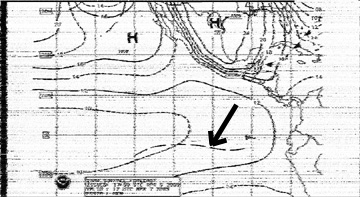
We download weather maps daily, they come over the radio and take about 15 minutes each to receive. The arrow points to our nemisis, a huge surface low pressure trough. |
We were at the end of our 21 day visa in the Galapagos, so it was time to go, unfortunately the weather did not look like it was going to cooperate. A surface low pressure trough was laying between us and those trusty trade winds. This meant we would have hundreds of miles with little wind, and possibly large thunder storms. We had plenty of fuel to motor through the area, so when we left we thought we would see the trade winds in a couple days. |
|
|
|
|
On our second day out we got a rude surprise. The seal around the propellor shaft had been leaking before arriving in the Galapagos. This seal consists of a stainless steel collar that turns with the prop shaft, a rubber bellows that is attached to the hull, and a composite plastic ring that the bellows holds tightly against the stainless collar. Paul adjusted it while in the Galapagos, and it seemed fine when we departed. On that second day it started leaking again, so Paul tightened it. It seems as though this second adjustment made things a bit too tight. After running the engine for an hour the smell of burning plastic filled the cabin. A quick inspection found no flames, but the plastic ring had melted, and welded itself to the stainless collar. The good news was the leak had stopped, the bad news was that turning the shaft could tear the bellows, causing a much larger leak that we didn't want to think about. It would have been almost impossible to return to the Galapagos because of weather and the strong currents, so we were now bound for the Gambiers as a pure sailboat! |
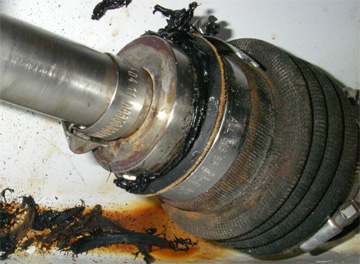
The seal around the prop shaft melted when overtightened. |
|
|
|
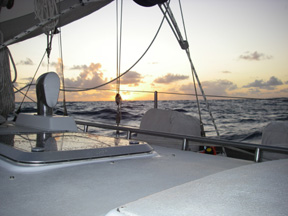
|
That first week we often sailed as little as 25 miles in a day. Fortunately there was a strong current that boosted us another 30 - 40 miles each day. The next week consisted of an area where there was good wind (10-25 knots) in the numerous large squalls, and nothing in between. The panorama at the top of the page shows us exiting one of these huge thunderstorms. On day nine we reached the trade winds. Needless to say, we were delighted to stop working so hard to make only 50 to 75 mile days. The following week was straight off the postcard, great sailing with consistent trade winds |
|
|
|
|
The weather department then decided we were having too much fun making those record 150+ mile days. A large low pressure system 500 miles to our south sent a frontal system up that brought us a week of lighter winds and buckets of rain. For the following week it was back to moving slow, lots of sail changes, and a grumpy crew. Eventually we got another ten days of good sailing before being nearly becalmed for two days before our arrival in the Gambiers. |
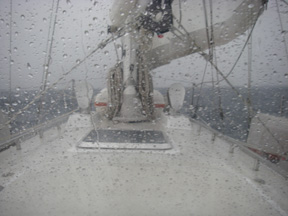
|
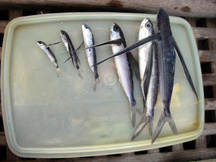
The catch of the day was mostly flying fish that got stranded on deck. |
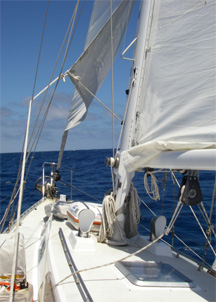
Some days we pulled the jib to the wrong side of the boat, to heave to. We could then shower, have lunch, and relax a bit with much nicer motion. |
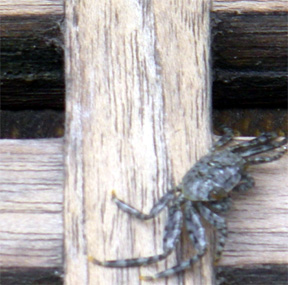
A couple small crabs have become our pets. They have found an active ecosystem in the cockpit that seems to sustain them. |
|
On our 28th day out Erin spotted the Gambiers at sunrise. Despite being only 30 miles away we had to spend another night at sea because the wind was light and we could not make it through the reef before dark. |
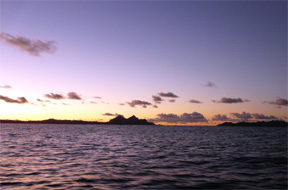
|
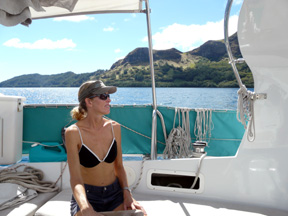
|
At noon on day 29 we sailed through the reef into our first tropical island paradise. |
|
Our trusty dinghy strapped to one side of the boat, and another cruiser's on the opposite side helped us in the final mile to the anchorage. |
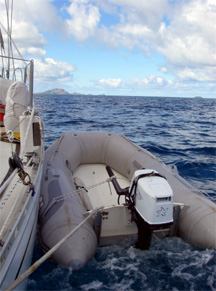
|

| Next Page |